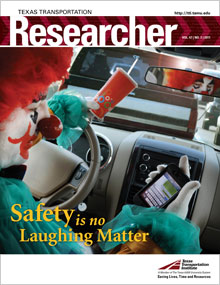Scanning Facility Opens at Riverside, Broadens Research Capabilities
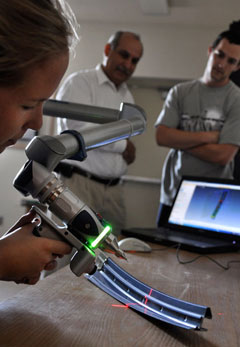
To further its effort under a grant from the U.S. State Department, the Texas Transportation Institute (TTI) has acquired a computer-modeling scanning system that ensures the Institute’s stature as one of the premier crash-testing facilities in the world.
The three-dimensional scanning device, called a FARO® Edge, allows TTI to scan vehicle parts and components of roadside safety and perimeter security devices for use in computer modeling to predict how they might react in a crash. (For more information about the FARO scanning system, view the company’s website at http://www.faro.com/edge/us.)
“Combining this new tool with our impact analysis software, TTI will be able to offer added value to our sponsors,” says Research Scientist Akram Abu-Odeh of TTI’s Roadside Safety and Physical Security Division.
“Full-scale crash tests are very expensive,” says Abu-Odeh. Computer modeling can be used to evaluate the impact performance of a device and, if needed, to permit the device to be modified prior to performing expensive crash tests.” In addition, Abu-Odeh says that computer modeling reduces the overall development cost of a product by decreasing the number of crash tests needed to arrive at a successful design.
The laser-scanning device is being used to meticulously map each component of a recently manufactured truck.
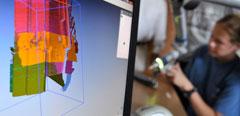
“Once we scan the entire truck with the FARO arm, we can begin doing computer-simulated crash tests on the various security devices being used at U.S. facilities overseas,” says TTI Associate Transportation Researcher Michael Brackin, who is co-leading the scanning project with Abu-Odeh.
It will take a full year to scan each component and develop the detailed finite element model of the truck.
“We are extremely pleased to have this sophisticated technology available for our program,” TTI Assistant Agency Director Dean Alberson says. “It greatly enhances our research capabilities and will undoubtedly open the door for
other work.”
SLIP SAFE Breakaway System Goes Big in Kansas
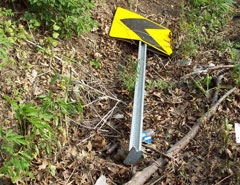
Joe Frazzetta of Nucor Steel-Marion Inc. is a believer. He decided to approach state departments of transportation (DOTs) with a Texas Transportation Institute (TTI)-designed and crash-tested product that has, for the most part, “needed a jump start regarding promotion and marketing.”
It’s called a SLIP SAFE™ breakaway system, designed for locations where signs are frequently hit. When a vehicle impacts a sign post, Nucor’s slip base allows the post to release from the base, causing minimal damage to the vehicle and the sign, depending on vehicle speed. The base remains in place, and with a new retainer plate, the existing sign and post are easily replaced, saving DOTs maintenance costs.
“The Kansas Department of Transportation [KDOT] told me they had a problem location where warning signs were always being knocked down by traffic,” Frazzetta said. “Working with KDOT, we put up SLIP SAFE units with our channel posts as part of a trial effort.”
Sure enough, a sign was hit, and someone with KDOT went out to take a look. The employee took pictures and sent an email to his boss. Those pictures and the email found their way to Frazzetta’s inbox: “The only damage was that the sign was bent a little. The system worked like it was designed to. Great product. The Nucor system has less parts and less damage when hit, very easy to repair.”
Tried and True — ET-2000 Guardrail Still Saving Lives
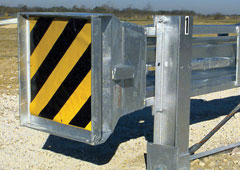
Most drivers throughout Texas and the country have seen the black-and-yellow-striped guardrail impact device known as the ET-2000 and not given it a second thought. Donny Ohana, undoubtedly, will never see them the same.
Recently, Ohana, his brother and two friends were traveling in a small car down a feeder road in Houston off I-610. As he sped up to enter the ramp, he lost control of his vehicle and impacted the guardrail head-on, eventually coming to a stop on a hill on the roadside.
“I looked around and saw that I was OK, and that my brothers and friends were OK,” says Ohana. “I couldn’t believe what had just happened. I was just sitting there scared.
“I’ll never forget this. One of the cops came up to me and said, ‘You know, you are very lucky because if the old guardrail was still there or a different system was in place, it would have gone right through your windshield.’”
The Texas Transportation Institute (TTI)-developed guardrail worked as designed, curling up upon impact and dissipating the forward motion of the car.
“That is one of the most notable inventions and safety devices that has ever been developed at TTI,” says retired TTI Research Engineer Hayes Ross, who was the principal investigator for the ET-2000. “You don’t have to go along far on any highway in the United States or other countries to recognize some of the hardware and safety features that were developed at TTI.”
